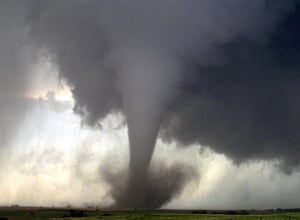There’s no sugar-coating the fact that this past winter has been a very harsh one. Much of the U.S. experienced more snow and ice than it had in years. With this severe weather came school and work closures; as well as, public transportation delays and shutdowns. On top of that, many roadside accidents. This winter 24% of all roadside accidents were related to snowy, slushy, or icy pavement. It’s no surprise that we all welcomed the first day of Spring with open arms - in search of sunshine, warm weather, and the promise of blooming flowers.
Unfortunately, for the Midwest, Spring means the start of tornado season. Tornados are more frequent in the U.S. than any other country, so it’s imperative that we are as prepared as possible; especially in the states East of the Rocky Mountains. Prior to having as much technology as we do now, tornado warnings were “issued” on a more local level after people on the ground observed darkening skies, rotation, or actually spotted a funnel. Today, technology has replaced observational identification providing a number of ways to detect the ripe conditions for severe weather in an effort to keep people safe and better informed of tornadoes approaching.
It isn’t a coincidence that the first day of Spring coincides with NOAA’s Severe Weather Awareness Week observed by a large majority of states. This week is dedicated to stressing the importance of preparing your organization and community with tornado safety information; as well as, testing what systems you currently have in place. Beyond this, it’s about ensuring your organization’s internal team knows what to do once a tornado warning or severe weather alert has been declared.
There are two ways that local governments inform those in a specified area of a tornado warning:
- WEA Alerts (Wireless Emergency Alerts) - These alerts are sent when the NWS has spotted a tornado in your area or when the Doppler Radar readings show they are soon to be present. These are a push alert that is sent to your mobile phones. Because WEA Alerts are only sent to mobile phones within the specific vicinity in which the tornado alert or warning is declared - many organizations are taking it upon themselves to alert their constituents of tornadoes and severe weather. You cannot assume that each person will be near their phones or computers to receive an emergency text or email.
- Tornado Sirens - Like the WEA Alerts, some of these are powered by the NWS findings of tornadoes in your area or Doppler Radar readings. Others are controlled by municipalities who manually sound the siren with the push of a button. These sirens will sound very loudly, but they only have the capability to reach those who are within one mile - to possibly two-mile - radius of the siren depending on the size and power behind it.
For organizations, your people might be on their way back to the area from an out of town meeting or simply coming in late - not checking their mobile phone and not in audible range of the tornado siren. You must use redundancy in your emergency response to ensure that each member of your organization receives the alert.
An Emergency Notification System (ENS) allows you to send out multiple alerts and guidance to specific Groups of people within your organization. All at once, you have the ability to send out unique, pre-scripted or automated alerts to your entire team. Safety and security teams are informed of an imminent tornado and told to secure all doors. While, at the same time, your IT staff is alerted of the potential electrical power disruption. Meanwhile, your facilities department is on standby with the potential to move to generators. What’s more important than simply sending the alert is ensuring the person receives and understands the message - this is why increasing your ways of communication is so important.
Sending a message to mobile phones and sounding a tornado siren will reach a lot of people, but not all of them. Being able to send out the same emergency message through multiple different channels, allows you to multiply your chances of reaching who you need to inform. Utilizing all your available resources can disseminate message alerts through all necessary devices to ensure that each individual is out of a tornado's path and reduce risk to people and the organization. Ultimately, increasing communication is a practical way to ensure that everyone is as safe as possible from tornadoes.
Tornado season starts in March and peaks from April to June. While you’re preparing your organization and community during your state’s specified Severe Weather Awareness Week, take some time to think about how you can do more to protect your people using your ENS.
To ensure you’re using all the channels possible to keep your people safe and informed download the Omnimodal Checklist.

